
A | B | C | D | E | F | G | H | CH | I | J | K | L | M | N | O | P | Q | R | S | T | U | V | W | X | Y | Z | 0 | 1 | 2 | 3 | 4 | 5 | 6 | 7 | 8 | 9
Toronto | |
|---|---|
| City of Toronto | |
| Etymology: From the Mohawk word tkaronto, the name of a channel between Lakes Simcoe and Couchiching | |
| Nicknames: | |
| Motto: | |
| Coordinates: 43°40′13″N 79°23′12″W / 43.67028°N 79.38667°W[4] | |
| Country | Canada |
| Province | Ontario |
| Established | August 27, 1793 (as York) |
| Incorporated | March 6, 1834 (as City of Toronto) |
| Amalgamated into division | January 20, 1953 (as Metropolitan Toronto) |
| Amalgamated | January 1, 1998 (as current City of Toronto) |
| Districts | |
| Government | |
| • Type | Single-tier municipality with a mayor–council system |
| • Mayor | Olivia Chow |
| • Deputy Mayor | Ausma Malik |
| • Body | Toronto City Council |
| Area | |
| • City | 630.20 km2 (243.32 sq mi) |
| • Urban | 1,792.99 km2 (692.28 sq mi) |
| • Metro | 5,905.71 km2 (2,280.21 sq mi) |
| Elevation | 76.5 m (251.0 ft) |
| Population | |
| • City | 2,794,356 (1st) |
| • Rank | 4th in North America 1st in Canada |
| • Density | 4,427.8/km2 (11,468/sq mi) |
| • Metro | 6,202,225 (1st) |
| • Region | 9,765,188 |
| Demonym | Torontonian |
| Time zone | UTC−05:00 (EST) |
| • Summer (DST) | UTC−04:00 (EDT) |
| Postal code span | |
| Area codes | 416, 647, 437 |
| GDP (Toronto CMA) | CA$442.2 billion (2019)[9] |
| GDP per capita (Toronto CMA) | CA$62,873 (2019) |
| Website | www |
Toronto (/təˈrɒntoʊ/, locally /təˈrɒnoʊ/) is the most populous city in Canada and the capital city of the Canadian province of Ontario. With a population of 2,794,356 in 2021,[10] it is the fourth-most populous city in North America. The city is the anchor of the Golden Horseshoe, an urban agglomeration of 9,765,188 people (as of 2021) surrounding the western end of Lake Ontario,[11] while the Greater Toronto Area proper had a 2021 population of 6,712,341.[10] Toronto is an international centre of business, finance, arts, sports and culture and is one of the most multicultural and cosmopolitan cities in the world.[12][13][14]
Indigenous peoples have travelled through and inhabited the Toronto area, located on a broad sloping plateau interspersed with rivers, deep ravines, and urban forest, for more than 10,000 years.[15] After the broadly disputed Toronto Purchase, when the Mississauga surrendered the area to the British Crown,[16] the British established the town of York in 1793 and later designated it as the capital of Upper Canada.[17] During the War of 1812, the town was the site of the Battle of York and suffered heavy damage by American troops.[18] York was renamed and incorporated in 1834 as the city of Toronto. It was designated as the capital of the province of Ontario in 1867 during Canadian Confederation.[19] The city proper has since expanded past its original limits through both annexation and amalgamation to its current area of 630.2 km2 (243.3 sq mi).
The diverse population of Toronto reflects its current and historical role as an important destination for immigrants to Canada.[20][21] About half of its residents were born outside of Canada and over 200 ethnic origins are represented among its inhabitants.[22] While the majority of Torontonians speak English as their primary language, over 160 languages are spoken in the city.[23] The mayor of Toronto is elected by direct popular vote to serve as the chief executive of the city. The Toronto City Council is a unicameral legislative body, comprising 25 councillors since the 2018 municipal election, representing geographical wards throughout the city.[24]
Toronto is a prominent centre for music,[25] theatre,[26] motion picture production,[27] and television production,[28] and is home to the headquarters of Canada's major national broadcast networks and media outlets .[29] Its varied cultural institutions,[30] which include numerous museums and galleries, festivals and public events, entertainment districts, national historic sites, and sports activities,[31] attract over 43 million tourists each year.[32][33] Toronto is known for its many skyscrapers and high-rise buildings,[34] in particular the tallest free-standing structure on land outside of Asia, the CN Tower.[35]
The city is home to the Toronto Stock Exchange, the headquarters of Canada's five largest banks,[36] and the headquarters of many large Canadian and multinational corporations.[37] Its economy is highly diversified with strengths in technology, design, financial services, life sciences, education, arts, fashion, aerospace, environmental innovation, food services, and tourism.[38][39][40] Toronto is the third-largest tech hub in North America after Silicon Valley and New York City, and the fastest growing hub.[41]
Toponymy
The word Toronto has been recorded with various spellings in French and English, including Tarento, Tarontha, Taronto, Toranto, Torento, Toronto, and Toronton.[42] Taronto referred to "The Narrows", a channel of water through which Lake Simcoe discharges into Lake Couchiching where the Huron had planted tree saplings to corral fish. This narrows was called tkaronto by the Mohawk, meaning "where there are trees standing in the water",[43][44][45] and was recorded as early as 1615 by Samuel de Champlain.[46] The word "Toronto", meaning "plenty", also appears in a 1632 French lexicon of the Huron language, which is also an Iroquoian language.[47] It also appears on French maps referring to various locations, including Georgian Bay, Lake Simcoe, and several rivers.[48] A portage route from Lake Ontario to Lake Huron running through this point, known as the Toronto Carrying-Place Trail, led to widespread use of the name.
The pronunciation of the city is broadly /təˈrɒntoʊ/ ⓘ tə-RON-toh, which locals pronounce /təˈrɒnoʊ/ or /ˈtrɒnoʊ/, leaving the second 't' silent.[49][50][51]
History
Early history
The site of Toronto lay at the entrance to one of the oldest routes to the northwest, a route known and used by the Huron, Iroquois, and Ojibwe. Archaeological sites show evidence of human occupation dating back thousands of years. The site was of strategic importance from the beginning of Ontario's recorded history.[52]
In the 1660s, the Iroquois established two villages within what is today Toronto, Ganatsekwyagon (Bead Hill) on the banks of the Rouge River and Teiaiagon on the banks of the Humber River. By 1701, the Mississaugas had displaced the Iroquois, who abandoned the Toronto area at the end of the Beaver Wars, with most returning to their homeland in present-day New York state.[53]
French traders founded Fort Rouillé in 1750 (the current Exhibition grounds were later developed there), but abandoned it in 1759 during the Seven Years' War.[54] The British defeated the French and their indigenous allies in the war, and the area became part of the British colony of Quebec in 1763.
During the American Revolutionary War, an influx of British settlers arrived there as United Empire Loyalists fled for the British-controlled lands north of Lake Ontario. The Crown granted them land to compensate for their losses in the Thirteen Colonies. The new province of Upper Canada was being created and needed a capital. In 1787, the British Lord Dorchester arranged for the Toronto Purchase with the Mississaugas of the New Credit First Nation, thereby securing more than a quarter of a million acres (1000 km2) of land in the Toronto area.[55] Dorchester intended the location to be named Toronto.[48] The first 25 years after the Toronto purchase were quiet, although "there were occasional independent fur traders" present in the area, with the usual complaints of debauchery and drunkenness.[52]
In 1793, Governor John Graves Simcoe established the town of York on the Toronto Purchase lands, naming it after Prince Frederick, Duke of York and Albany. Simcoe decided to move the Upper Canada capital from Newark (Niagara-on-the-Lake) to York,[56] believing the new site would be less vulnerable to attack by the United States.[57] The York garrison was built at the entrance of the town's natural harbour, sheltered by a long sand-bar peninsula. The town's settlement formed at the harbour's eastern end behind the peninsula, near the present-day intersection of Parliament Street and Front Street (in the "Old Town" area).
19th century

In 1813, as part of the War of 1812, the Battle of York ended in the town's capture and plunder by United States forces.[58] John Strachan negotiated the town's surrender. American soldiers destroyed much of the garrison and set fire to the parliament buildings during their five-day occupation. Because of the sacking of York, British troops retaliated later in the war with the burning of Washington, D.C.
York was incorporated as the City of Toronto on March 6, 1834, adopting the Indigenous name.[citation needed] Reformist politician William Lyon Mackenzie became the first mayor of Toronto. Mackenzie would later lead the unsuccessful Upper Canada Rebellion of 1837 against the British colonial government.
Toronto's population of 9,000 included some African-American slaves,[citation needed] some of whom had been brought by the Loyalists, and Black Loyalists, whom the Crown had freed (most of the latter were resettled in Nova Scotia). By 1834, refugee slaves from America's South were also immigrating to Toronto to gain freedom.[59] Slavery was banned outright in Upper Canada (and throughout the British Empire) in 1834.[60] Torontonians integrated people of colour into their society. In the 1840s, an eating house at Frederick and King Streets, a place of mercantile prosperity in the early city, was operated by a black man named Bloxom.[61]

As a major destination for immigrants to Canada, the city grew rapidly through the remainder of the 19th century. The first significant wave of immigrants were Irish, fleeing the Great Irish Famine; most of them were Catholic. By 1851, the Irish-born population had become the largest single ethnic group in the city. The Scottish and English population welcomed smaller numbers of Protestant Irish immigrants, some from what is now Northern Ireland, which gave the Orange Order significant and long-lasting influence over Toronto society. Almost every mayor of Toronto was a member of the Orange Order between 1850 and 1950, and the city was sometimes referred to as the "Belfast of Canada" because of Orange influence in municipal politics and administration.[62]
For brief periods, Toronto was twice the capital of the united Province of Canada: first from 1849 to 1851, following unrest in Montreal, and later from 1855 to 1859. After this date, Quebec was designated as the capital until 1865 (two years before Canadian Confederation). Since then, the capital of Canada has remained Ottawa, Ontario.[63]
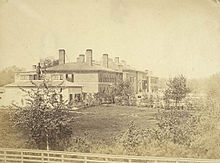
Toronto became the capital of the province of Ontario after its official creation in 1867. The seat of government of the Ontario briefly returned to the same building that hosted the Third Parliament Building of Upper Canada, before moving to the Ontario Legislative Building at Queen's Park in 1893. Because of its provincial capital status, the city was also the location of Government House, the residence of the viceregal representative of the Crown in right of Ontario.
Long before the Royal Military College of Canada was established in 1876, supporters of the concept proposed military colleges in Canada. Staffed by British Regulars, adult male students underwent a three-month-long military course at the School of Military Instruction in Toronto. Established by Militia General Order in 1864, the school enabled officers of militia or candidates for commission or promotion in the Militia to learn military duties, drill and discipline, to command a company at Battalion Drill, to drill a company at Company Drill, the internal economy of a company, and the duties of a company's officer.[64] The school was retained at Confederation, in 1867. In 1868, Schools of cavalry and artillery instruction were formed in Toronto.[65]

In the 19th century, the city built an extensive sewage system to improve sanitation, and streets were illuminated with gas lighting as a regular service.[citation needed] Long-distance railway lines were constructed, including a route completed in 1854 linking Toronto with the Upper Great Lakes. The Grand Trunk Railway and the Northern Railway of Canada joined in the building of the first Union Station in downtown. The advent of the railway dramatically increased the numbers of immigrants arriving, commerce and industry, as had the Lake Ontario steamers and schooners entering port before. These enabled Toronto to become a major gateway linking the world to the interior of the North American continent. Expanding port and rail facilities brought in northern timber for export and imported Pennsylvania coal. Industry dominated the waterfront for the next 100 years.
During the late 19th century, Toronto became the largest alcohol distillation (in particular, spirits) centre in North America. By the 1860s, the Gooderham and Worts Distillery operations became the world's largest whisky factory.[citation needed] A preserved section of this once dominant local industry remains in the Distillery District. The harbour allowed access to grain and sugar imports used in processing.

Horse-drawn streetcars gave way to electric streetcars in 1891 when the city granted the operation of the transit franchise to the Toronto Railway Company. The public transit system passed into public ownership in 1921 as the Toronto Transportation Commission, later renamed the Toronto Transit Commission. The system now has the third-highest ridership of any city public transportation system in North America.[66]
20th century
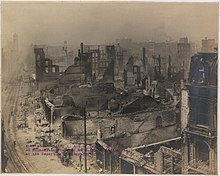
The Great Toronto Fire of 1904 destroyed a large section of downtown Toronto. The fire destroyed more than 100 buildings.[67] The fire claimed one victim, John Croft, who was an explosive expert clearing the ruins from the fire.[68] It caused CA$10,387,000 in damage (roughly CA$277,600,000 in 2020 terms).[69]
The city received new European immigrant groups from the late 19th century into the early 20th century, particularly Germans, French, Italians, and Jews. They were soon followed by Russians, Poles, and other Eastern European nations, in addition to the Chinese entering from the West. Like the Irish before them, many of these migrants lived in overcrowded shanty-type slums, such as "the Ward", which was centred on Bay Street, now the heart of the country's Financial District.
As new migrants began to prosper, they moved to better housing in other areas, in what is now understood to be succession waves of settlement. Despite its fast-paced growth, by the 1920s, Toronto's population and economic importance in Canada remained second to the much longer established Montreal, Quebec. However, by 1934, the Toronto Stock Exchange had become the largest in the country.
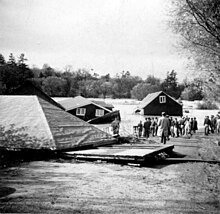
In 1954, the City of Toronto and 12 surrounding municipalities were federated into a regional government known as Metropolitan Toronto.[70] The postwar boom had resulted in rapid suburban development. It was believed a coordinated land-use strategy and shared services would provide greater efficiency for the region. The metropolitan government began to manage services that crossed municipal boundaries, including highways, police services, water and public transit. In that year, a half-century after the Great Fire of 1904, disaster struck the city again when Hurricane Hazel brought intense winds and flash flooding. In the Toronto area, 81 people were killed, nearly 1,900 families were left homeless, and the hurricane caused more than CA$25 million in damage.[71]
In 1967, the seven smallest municipalities of Metropolitan Toronto were merged with larger neighbours, resulting in a six-municipality configuration that included the former city of Toronto and the surrounding municipalities of East York, Etobicoke, North York, Scarborough, and York.[72]
In the decades after World War II, refugees from war-torn Europe and Chinese job-seekers arrived, as well as construction labourers, particularly from Italy and Portugal. Toronto's population grew to more than one million in 1951 when large-scale suburbanization began and doubled to two million by 1971. Following the elimination of racially based immigration policies by the late 1960s, Toronto became a destination for immigrants from all over the world. By the 1980s, Toronto had surpassed Montreal as Canada's most populous city and chief economic hub. During this time, in part owing to the political uncertainty raised by the resurgence of the Quebec sovereignty movement, many national and multinational corporations moved their head offices from Montreal to Toronto and Western Canadian cities.[73]

On January 1, 1998, Toronto was greatly enlarged, not through traditional annexations, but as an amalgamation of the Municipality of Metropolitan Toronto and its six lower-tier constituent municipalities: East York, Etobicoke, North York, Scarborough, York, and the original city itself. They were dissolved by an act of the Government of Ontario and formed into a single-tier City of Toronto (colloquially dubbed the "megacity"), replacing all six governments.
The merger was proposed as a cost-saving measure by the Progressive Conservative provincial government under premier Mike Harris. The announcement touched off vociferous public objections. In March 1997, a referendum in all six municipalities produced a vote of more than 3:1 against amalgamation.[74] However, municipal governments in Canada are creatures of the provincial governments, and referendums have little to no legal effect. The Harris government could thus legally ignore the referendum results and did so in April when it tabled the City of Toronto Act. Both opposition parties held a filibuster in the provincial legislature, proposing more than 12,000 amendments that allowed residents on streets of the proposed megacity to take part in public hearings on the merger and adding historical designations to the streets.[75] This only delayed the bill's inevitable passage, given the Progressive Conservatives' majority.
North York mayor Mel Lastman became the first "megacity" mayor, and the 62nd mayor of Toronto, with his electoral victory.[76] Lastman gained national attention after multiple snowstorms, including the January Blizzard of 1999, dumped 118 centimetres (46 in) of snow and effectively immobilized the city.[77][78] He called in the Canadian Army to aid snow removal by use of their equipment to augment police and emergency services. The move was ridiculed by some in other parts of the country, fuelled in part by what was perceived as a frivolous use of resources.[79][80]
21st century

The city attracted international attention in 2003 when it became the centre of a major SARS (severe acute respiratory syndrome) outbreak. Public health attempts to prevent the disease from spreading elsewhere temporarily dampened the local economy.[81] From August 14 to 17, 2003, the city was hit by a massive blackout which affected millions of Torontonians (it also affected most of Southern Ontario and parts of the United States), stranding some hundreds of people in tall buildings, knocking out traffic lights and suspending subway and streetcar service across the city during those aforementioned days.[82]
On March 6, 2009, the city celebrated the 175th anniversary of its inception as the City of Toronto in 1834. Toronto hosted the 4th G20 summit during June 26–27, 2010. This included the largest security operation in Canadian history. Following large-scale protests and rioting, law enforcement arrested more than 1,000 people, the largest mass arrest in Canadian history.[83]
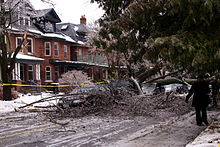
On July 8, 2013, severe flash flooding hit Toronto after an afternoon of slow-moving, intense thunderstorms. Toronto Hydro estimated 450,000 people were without power after the storm and Toronto Pearson International Airport reported 126 mm (5 in) of rain had fallen over five hours, more than during Hurricane Hazel.[84] Within six months, from December 20 to 22, 2013, Toronto was brought to a near halt by the worst ice storm in the city's history, rivalling the severity of the 1998 Ice Storm (which mainly affected southeastern Ontario, and Quebec). At the height of the storm, over 300,000 Toronto Hydro customers had no electricity or heating.[85] Toronto hosted WorldPride in June 2014,[86] and the Pan and Parapan American Games in 2015.[87]
The city continues to grow and attract immigrants. A 2019 study by Toronto Metropolitan University (then known as Ryerson University) showed that Toronto was the fastest-growing city in North America. The city added 77,435 people between July 2017 and July 2018. The Toronto metropolitan area was the second-fastest-growing metropolitan area in North America, adding 125,298 persons, compared with 131,767 in the Dallas–Fort Worth–Arlington metroplex in Texas. The large growth in the Toronto metropolitan area is attributed to international migration to Toronto.[88]
The COVID-19 pandemic in Canada first occurred in Toronto and was among the hotspots in the country.[89][90]
Toronto was named as one of 16 cities in North America (and one of two Canadian cities) to host matches for the 2026 FIFA World Cup.[91]
Geography

Toronto covers an area of 630 square kilometres (243 sq mi),[92] with a maximum north–south distance of 21 kilometres (13 mi). It has a maximum east–west distance of 43 km (27 mi), and it has a 46-kilometre (29 mi) long waterfront shoreline, on the northwestern shore of Lake Ontario. The Toronto Islands and Port Lands extend out into the lake, allowing for a somewhat sheltered Toronto Harbour south of the downtown core.[93] An Outer Harbour was constructed southeast of downtown during the 1950s and 1960s, and it is now used for recreation. The city's limits are formed by Lake Ontario to the south, the western boundary of Marie Curtis Park, Etobicoke Creek, Eglinton Avenue and Highway 427 to the west, Steeles Avenue to the north and the Rouge River and the Scarborough–Pickering Townline to the east.
Topography
This section needs additional citations for verification. (July 2016) |

The city is mostly flat or gentle hills, and the land gently slopes upward away from the lake. The flat land is interrupted by the Toronto ravine system, which is cut by numerous creeks and rivers of the Toronto waterway system, most notably the Humber River in the west end, the Don River east of downtown (these two rivers flanking and defining the Toronto Harbour), and the Rouge River at the city's eastern limits. Most of the ravines and valley lands in Toronto today are parklands and recreational trails are laid out along the ravines and valleys. The original town was laid out in a grid plan on the flat plain north of the harbour, and this plan was extended outwards as the city grew. The width and depth of several of the ravines and valleys are such that several grid streets, such as Finch Avenue, Leslie Street, Lawrence Avenue, and St. Clair Avenue, terminate on one side of a ravine or valley and continue on the other side. Toronto has many bridges spanning the ravines. Large bridges such as the Prince Edward Viaduct were built to span broad river valleys.
Despite its deep ravines, Toronto is not remarkably hilly, but its elevation does increase steadily away from the lake. Elevation differences range from 76.5 metres (251 ft) above sea level at the Lake Ontario shore to 209 m (686 ft) above sea level near the York University grounds in the city's north end at the intersection of Keele Street and Steeles Avenue.[94] There are occasional hilly areas; in particular, midtown Toronto has several sharply sloping hills. Lake Ontario remains occasionally visible from the peaks of these ridges as far north as Eglinton Avenue, 7 to 8 kilometres (4.3 to 5.0 mi) inland.
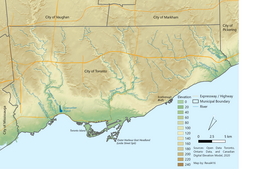
The other major geographical feature of Toronto is its escarpments. During the last ice age, the lower part of Toronto was beneath Glacial Lake Iroquois. Today, a series of escarpments mark the lake's former boundary, known as the "Iroquois Shoreline". The escarpments are most prominent from Victoria Park Avenue to the mouth of Highland Creek, where they form the Scarborough Bluffs. Other observable sections include the area near St. Clair Avenue West between Bathurst Street and the Don River, and north of Davenport Road from Caledonia to Spadina Road; the Casa Loma grounds sit above this escarpment.[95]
The geography of the lakeshore has dramatically changed since the first settlement of Toronto. Much of the land on the harbour's north shore is landfill, filled in during the late 19th century. Until then, the lakefront docks (then known as wharves) were set back farther inland than today. Much of the adjacent Port Lands on the harbour's east side was a wetland filled in early in the 20th century.[96] The shoreline from the harbour west to the Humber River has been extended into the lake. Further west, landfill has been used to create extensions of land such as Humber Bay Park.

The Toronto Islands were a natural peninsula until a storm in 1858 severed their connection to the mainland,[97] creating a channel to the harbour. The peninsula was formed by longshore drift taking the sediments deposited along the Scarborough Bluffs shore and transporting them to the Islands area.
The other source of sediment for the Port Lands wetland and the peninsula was the deposition of the Don River, which carved a wide valley through the sedimentary land of Toronto and deposited it in the shallow harbour. The harbour and the channel of the Don River have been dredged numerous times for shipping. The lower section of the Don River was straightened and channelled in the 19th century. The former mouth drained into a wetland; today, the Don River drains into the harbour through a concrete waterway, the Keating Channel. To mitigate flooding in the area, as well as to create parkland, a second more natural mouth is being built to the south during the first half of the 2020s, thereby creating Villiers Island.
Neighbourhoods and former municipalities

Toronto encompasses an area formerly administered by several separate municipalities that were amalgamated over the years. Each developed a distinct history and identity over the years, and their names remain in common use among Torontonians. Former municipalities include East York, Etobicoke, Forest Hill, Mimico, North York, Parkdale, Scarborough, Swansea, Weston and York. Throughout the city, there exist hundreds of small neighbourhoods and some larger neighbourhoods covering a few square kilometres.[citation needed]
The many residential communities of Toronto express a character distinct from the skyscrapers in the commercial core. Victorian and Edwardian-era residential buildings can be found in enclaves such as Rosedale, Cabbagetown, The Annex, and Yorkville.[98] The Wychwood Park neighbourhood, historically significant for the architecture of its homes, and for being one of Toronto's earliest planned communities, was designated as an Ontario Heritage Conservation district in 1985.[99] The Casa Loma neighbourhood is named after "Casa Loma", a castle built in 1911 by Sir Henry Pellat, complete with gardens, turrets, stables, an elevator, secret passages, and a bowling alley.[100] Spadina House is a 19th-century manor that is now a museum.[101]
Old Toronto

The pre-amalgamation City of Toronto covers the downtown core and older neighbourhoods to the east, west, and north. It is the most densely populated part of the city. The Financial District contains the First Canadian Place, Toronto-Dominion Centre, Scotia Plaza, Royal Bank Plaza, Commerce Court and Brookfield Place. This area includes, among others, the neighbourhoods of St. James Town, Garden District, St. Lawrence, Corktown, and Church and Wellesley. From that point, the Toronto skyline extends northward along Yonge Street.[citation needed]
Old Toronto is also home to many historically wealthy residential enclaves, such as Yorkville, Rosedale, The Annex, Forest Hill, Lawrence Park, Lytton Park, Deer Park, Moore Park, and Casa Loma, most stretching away from downtown to the north.[citation needed] East and west of downtown, neighbourhoods such as Kensington Market, Chinatown, Leslieville, Cabbagetown and Riverdale are home to bustling commercial and cultural areas as well as communities of artists with studio lofts, with many middle- and upper-class professionals.[citation needed] Other neighbourhoods in the central city retain an ethnic identity, including two smaller Chinatowns, the Greektown area, Little Italy, Portugal Village, and Little India, among others.[102]
Suburbs
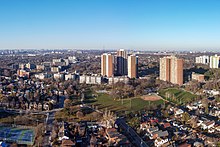
The inner suburbs are contained within the former municipalities of York and East York.[103] These are mature and traditionally working-class areas, consisting primarily of post–World War I small, single-family homes and small apartment blocks.[103] Neighbourhoods such as Crescent Town, Thorncliffe Park, Flemingdon Park, Weston, and Oakwood Village consist mainly of high-rise apartments, which are home to many new immigrant families. During the 2000s, many neighbourhoods became ethnically diverse and underwent gentrification due to increasing population and a housing boom during the late 1990s and the early 21st century. The first neighbourhoods affected were Leaside and North Toronto, gradually progressing into the western neighbourhoods in York.[citation needed]

The outer suburbs comprising the former municipalities of Etobicoke (west), Scarborough (east) and North York (north) largely retain the grid plan laid before post-war development.[104] Sections were long established and quickly growing towns before the suburban housing boom began and the emergence of metropolitan government, existing towns or villages such as Mimico, Islington and New Toronto in Etobicoke; Willowdale, Newtonbrook and Downsview in North York; Agincourt, Wexford and West Hill in Scarborough where suburban development boomed around or between these and other towns beginning in the late 1940s. Upscale neighbourhoods were built, such as the Bridle Path in North York, the area surrounding the Scarborough Bluffs in Guildwood, and most of central Etobicoke, such as Humber Valley Village, and The Kingsway. One of the largest and earliest "planned communities" was Don Mills, parts of which were first built in the 1950s.[105] Phased development, mixing single-detached housing with higher-density apartment blocks, became more popular as a suburban model of development. Over the late 20th century and early 21st century, North York City Centre, Etobicoke City Centre and Scarborough City Centre have emerged as secondary business districts outside Downtown Toronto. High-rise development in these areas has given the former municipalities distinguishable skylines of their own, with high-density transit corridors serving them; some of these developments are also transit-oriented.[citation needed]
Industrial
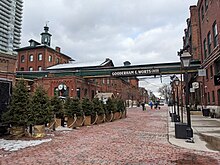
In the 1800s, a thriving industrial area developed around Toronto Harbour and the lower Don River mouth, linked by rail and water to Canada and the United States. Examples included the Gooderham and Worts Distillery, Canadian Malting Company, the Toronto Rolling Mills, the Union Stockyards and the Davies pork processing facility (the inspiration for the "Hogtown" nickname).[106][107] This industrial area expanded west along the harbour and rail lines and was supplemented by the infilling of the marshlands on the east side of the harbour to create the Port Lands. A garment industry developed along lower Spadina Avenue, the "Fashion District". Beginning in the late 19th century, industrial areas were set up on the outskirts, such as West Toronto / The Junction, where the Stockyards relocated in 1903.[108] The Great Fire of 1904 destroyed a large amount of industry in the downtown. Some companies moved west along King Street, and some moved as far west as Dufferin Street, where the large Massey-Harris farm equipment manufacturing complex was located.[109] Over time, pockets of industrial land mostly followed rail lines and later highway corridors as the city grew outwards. This trend continues to this day; the largest factories and distribution warehouses are in the suburban environs of Peel and York Regions, but also within the current city: Etobicoke (concentrated around Pearson Airport), North York, and Scarborough.[citation needed]

Many of Toronto's former industrial sites close to (or in) downtown have been redeveloped, including parts of the Toronto waterfront, the rail yards west of downtown, and Liberty Village, the Massey-Harris district and large-scale development is underway in the West Don Lands.[citation needed] The Gooderham & Worts Distillery produced spirits until 1990 and is preserved today as the "Distillery District", the largest and best-preserved collection of Victorian industrial architecture in North America.[110] Some industry remains in the area, including the Redpath Sugar Refinery. Similar areas that retain their industrial character but are now largely residential are the Fashion District, Corktown, and parts of South Riverdale and Leslieville. Toronto still has some active older industrial areas, such as Brockton Village, Mimico and New Toronto. In the west end of Old Toronto and York, the Weston/Mount Dennis and The Junction areas still contain factories, meat-packing facilities and rail yards close to medium-density residential. However, the Junction's Union Stockyards moved out of Toronto in 1994.[108]
The brownfield industrial area of the Port Lands, on the east side of the harbour, is one area planned for redevelopment.[111] Formerly a marsh that was filled in to create industrial space, it was never intensely developed — its land unsuitable for large-scale development — because of flooding and unstable soil.[112] It still contains numerous industrial uses, such as the Portlands Energy Centre power plant, port facilities, movie and TV production studios, concrete processing facilities, and low-density industrial facilities. The Waterfront Toronto agency has developed plans for a naturalized mouth to the Don River and to create a flood barrier around the Don, making more of the land on the harbour suitable for higher-value residential and commercial development.[113] A former chemicals plant site along the Don River is slated to become a large commercial complex and transportation hub.[114]
Architecture

Toronto's buildings vary in design and age, with many structures dating back to the early 19th century, while other prominent buildings were just newly built in the first decade of the 21st century.[115] Lawrence Richards, a member of the Faculty of Architecture at the University of Toronto, has said, "Toronto is a new, brash, rag-tag place—a big mix of periods and styles."[116] Bay-and-gable houses, mainly found in Old Toronto, are a distinct architectural feature of the city. Defining the Toronto skyline is the CN Tower, a telecommunications and tourism hub. Completed in 1976 at a height of 553.33 metres (1,815 ft 5 in), it was the world's tallest[117] freestanding structure until 2007 when it was surpassed by Burj Khalifa in Dubai.[118]
Toronto is a city of high-rises and had 1,875 buildings over 30 metres (98 ft) as of 2011.[119]
Through the 1960s and 1970s, significant pieces of Toronto's architectural heritage were demolished to make way for redevelopment or parking. In contrast, since 2000, amid the Canadian property bubble, Toronto has experienced a condo construction boom and architectural revival, with several buildings opened by world-renowned architects. Daniel Libeskind's Royal Ontario Museum addition, Frank Gehry's remake of the Art Gallery of Ontario, and Will Alsop's distinctive OCAD University expansion are among the city's new showpieces.[120] The mid-1800s Distillery District, on the eastern edge of downtown, has been redeveloped into a pedestrian-oriented arts, culture and entertainment neighbourhood.[121] This construction boom has some observers call the phenomenon the Manhattanization of Toronto after the densely built island borough of New York City.[122]













